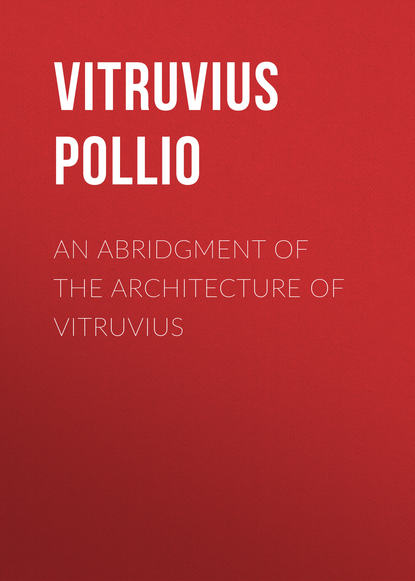 Полная версия
Полная версияAn Abridgment of the Architecture of Vitruvius
They made use of the same Machine on the Land, fixing to the Nave of the VVheel of a Coach, a Tooth which made many VVheels be turned as in the above-mentioned Machine, at the last of which, was fastned a Pin or Handle, which marked the number of Perches and Leagues. This Machine had likewise a sort of a Counting VVheel, which at every Mile that the Coach went, let a Pibble fall into a Vessel of Brass, to give notice that they had gone a Mile.
ART. VIIOf Machines of WarLib. 10.
Chap. 15. THE Machines of VVar of the Ancients were of three Sorts, for they were made either to Lance, Arrows, such as were the Scorpions or Javelins, such as were the Catapulta’s, or Stones, such as were Ballista’s or fiery Darts, such as were the Pyroboli, or they were made to beat down the VValls, such as were the battering Rams, and the Terebra, or to come covered to the VValls, and so safely Mount the Ramparts, such as were the Tortoises or Testudo’s, and the Towers of VVood.
Lib. 10.
Chap. 18. The Scorpions were a sort of great Crossbows, which were made use of to defend the VValls, and which likewise the Assailants made use of in the wooden Towers, to annoy those that defended the VValls.
The Catapulta, lanced Javelins or Javelots, from 12 to 15 Foot in length, they were made of two Trees, set one against another, like the Masts of a Ship, which were bended in drawing them with a Hand-Mill. These Trees being on a suddain unbent, furiously struck together, and forced violently the Javelin. They were bent the one after the other by the same Cord, which was made of Guts, to the end, that the Master who managed the Engine, might be assured, that the two Trees or Beams were equally bent. He knew it by sounding the Cord when both the Beams were bent, and when the End above was drawn even to the Capital of the Machine, where they were stayed by a Pin of Iron, which was driven out by a quick stroke of a Hammer when they unbent it. There was a Cylinder which traversed an excentrical piece, by the help of which they heightned, or let down the End of one of the Beams below, according as the Master of the Machine judged it necessary, for the augmenting or diminishing their bent, which was known by the sound of the Cord, which was alike in both, when they were equally bent. See Table XI.
The Ballista’s were bended and strung as the Catapulta’s, but instead of Javelins, they cast great Stones.
Lib. 10.
Chap. 22. The Pyroboli were Machines, which lanced or cast Darts, to vvhich vvas fixed combustible Matter, vvhich was kindled vvhen they darted it against Machines of VVar or Shipping.
The Ram vvas to beat dovvn Walls and make breaches. It vvas a great Beam headed with Iron; it vvas hung by the middle, and pushed by the Soldiery vvith great violence against the Walls.
The Terebra vvas something like the Ram, being a strong Beam pointed vvith Iron, but it vvas sharp pointed, and it made vvay for the Ram, splitting the Stones.
Lib. 10.
Chap. 20. The Testudo or Tortoise, vvere great large and low Towers of Wood, which were rowled upon six or eight Wheels, they were covered with raw Hides to defend them from fire. Their use was to cover them that approached the Walls to undermine them, or beat them with the battering Ram.
The Towers of Wood were made to raise the Assailants as high as the Walls, to chace the Besieged away with Arrows and Scorpions, and to lay Bridges from the Towers to the Wall; they were sometimes Thirty Fathoms high, having Twenty Stages. They were covered, as the Tortoises with raw Hides; they had each of them a Hundred Men, which were employed as well to move them, as to annoy the Besieged.
FINISADVERTISEMENT
The Figures inserted here are those only which are chiefly necessary to the understanding of Vitruvius, that is to say, those which serve for the comprehending the Rules that Architecture gives for Buildings, now in use. The Figures of other things, of which Vitruvius treats, are omitted, it being enough to give One only, to serve as an Example of each kind, viz. one for all Temples, one for all Theatres, and one for all Machines.
THE EXPLICATION Of the First TableThis Table contains the seven several sorts of Masonry; A is the first, which was called Reticulatum, because it was like the Mashes of Nets; BB is the second, it’s called Insertum, that is to say, bound Masonry, because the Stones are one bound within another, every one being bound with four, two below, and two above: CC is the third sort, which was particular to the Greeks; it may be called double binding, for it’s not only of Stones of the same course, but of two courses III. D is the fourth, called Isodomum, because the Beds or Lays are equal in height. E is the fifth, called Pseudisodomum, because they are of an equal heighth. FF, GG, H is the sixth, called Emplecton, because it was filled up any way in the middle. FF are the Stones which make the Courses. K is the seventh, which may be called Compound, because its Courses are of hewn Stone, and the middle filled up with Rubbish; and these Courses are fasten'd together with Cramp-irons.
This Table refers to pag. 47.
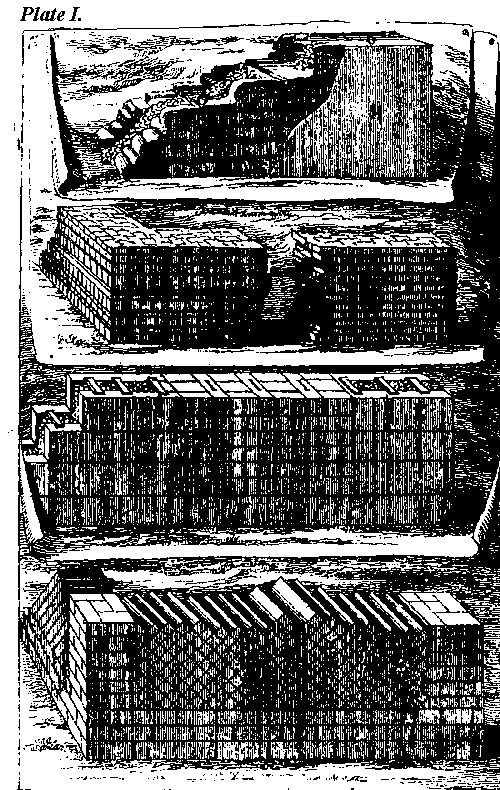
This Table contains the five sorts of Edifices: AA is the Pycnostyle; that is to say, where the Pillars are very close, the Intercolumniation being but of one Diameter, and a half of the Column: BB is the Systyle, viz. where the Pillars have two Diameters of Intercolumniation: CC is the Diastyle, viz. where the Pillars are at that distance, that they have for the Intercolumniation three Diameters: DD is the Areostyle, where the Pillars are far asunder. There is no certain Proportion; we have given in this Figure four Diameters of Intercolumniation, it may have more: The fifth sort called Eustyle, is in the third Table.
This Table refers to pag. 80.
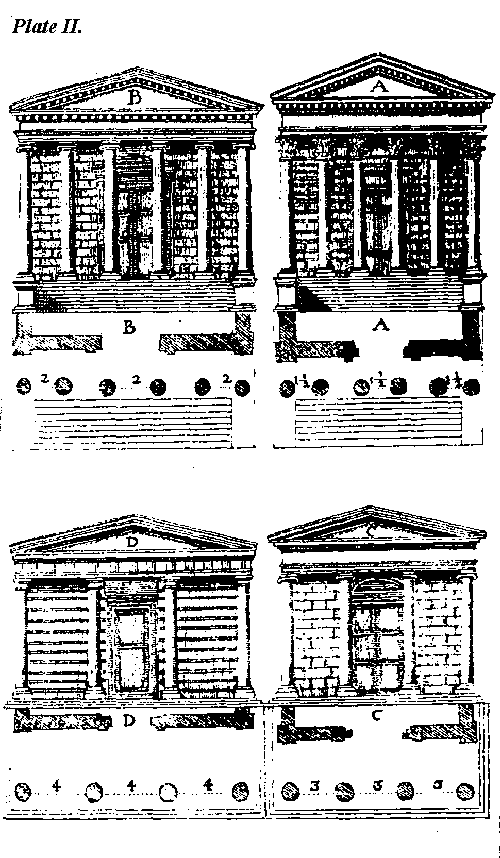
This Table contains the Plan and Elevation of the fifth sort of Edifices, called Eustyle, viz. where the Pillars are distant one from another by more convenient Proportion: Its Intercolumniations have all two Diameters and a quarter, except the Intercolumniations in the middle of the Face before and behind, which have three Diameters.
This plan shews the different parts of the ancient Temples: AA, AA, are the Isles or Wings which are Portico’s, having a rang of Pillars on the one side, and the Wall of the Temple on the other. B is the part called the Pronaos or Porch. C is the part called Posticum, viz. the hinder part of the Temple. D is that Part called Cella, or the Nave or Body of the Temple.
This Table relates to p. 81, & 117.
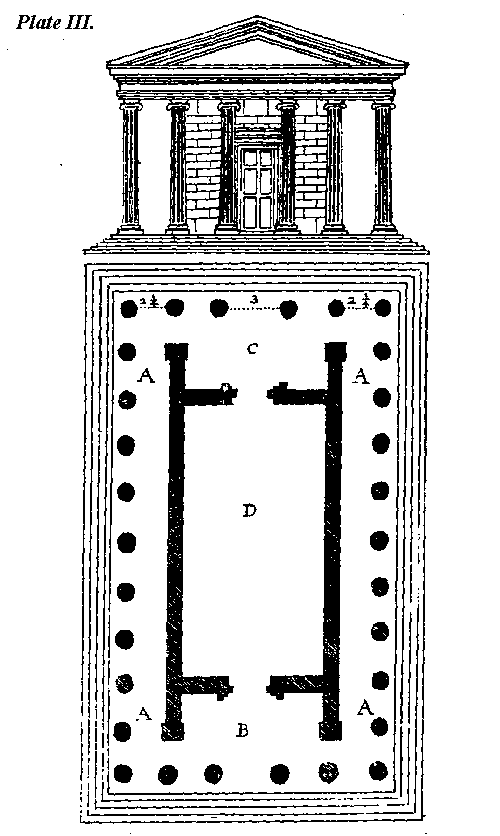
This Table contains the Plan and perspective Elevation of a Temple, called Hexastyle and Pseudodyptere, viz. Which has six Columns in the Faces, before and behind, and which has simple Portico’s, but which are as large as the two Portico’s of the Temples which have them double. This Plan and this Elevation may serve for other Temples, which as to what concerns the essential parts explained in the precedent Table, are like to this here, as are the Periptere, the Diptere, and the Hypethre, which only differ in the number of Columns, or such-like circumstances.
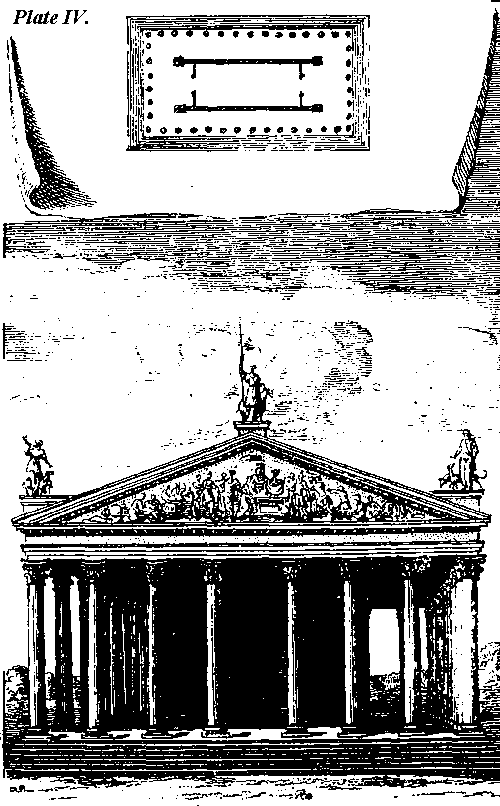
This contains the Proportions of the Tuscan Order. AA is the Base of the Column, which has for its height the first Semidiameter of the Column: It’s divided into two equal parts; that below is for the Plinth, marked I; that above, marked K, is for the Thorus, and for the Congè or Apophygis. BB is the Capital, which height is equal to its Base: It’s divided into three; the first marked L, is for the Gorge, with the Congè and the Astragal; the second, marked M, is for the Echinus or quarter-round; the third, marked N, is for the Plinthus or Abacus, called by the French Tallor. C is one of the Faces of the Sabliers which serve instead of an Architrave. EE is the under part of the Sabliers, which answers to the Diameter on the top of the Column, marked D. F is a Tenon shaped like a Swallows Tayl, which joyns the two Sabliers together. G is the little Wall which serves for a Frize. H is the Cornice.
This Table relates to pag. 93.
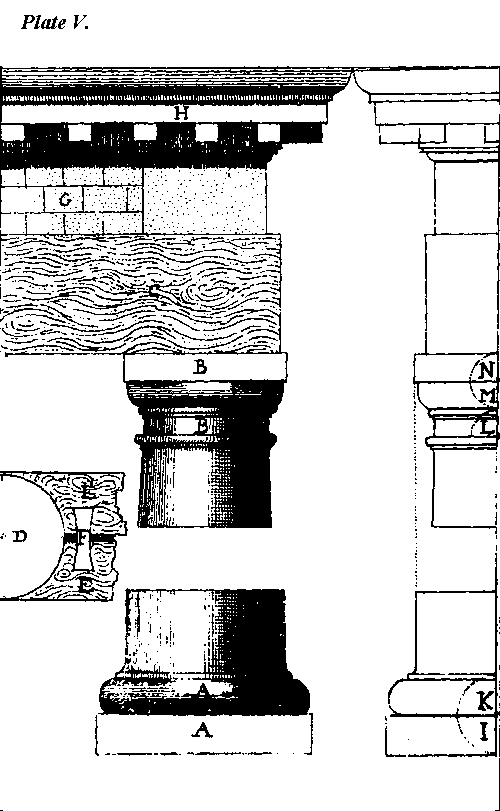
This contains the Proportion of the Dorick Order; AB is the top of the Shaft of the Column; this top shews the Plan of the two sorts of Channelling or Fluting, which are particular to the Dorick Order. The one half has Channelling or Fluting that is not hollowed, and make only Flat Faces or Pans. B is the other half, which has Channelings a little hollowed, viz. one quarter of the Circle: They are formed by the help of a Square C, whose sides are equal to every one of the Pans. D E F is the Capital divided into three equal parts. D is for the Gorge; E is for the Echinus, and for the Anulets or Rings; F is for the Abacus; G is the Architrave; H is the Triglyph; I is the Metop; K is the Demi-metop; L is the Cornice; M are the six pendant Drops which are under the Triglyph; N, O are the Pendant Drops which are in the Platfond of the Cornice.
This relates to pag. 96.
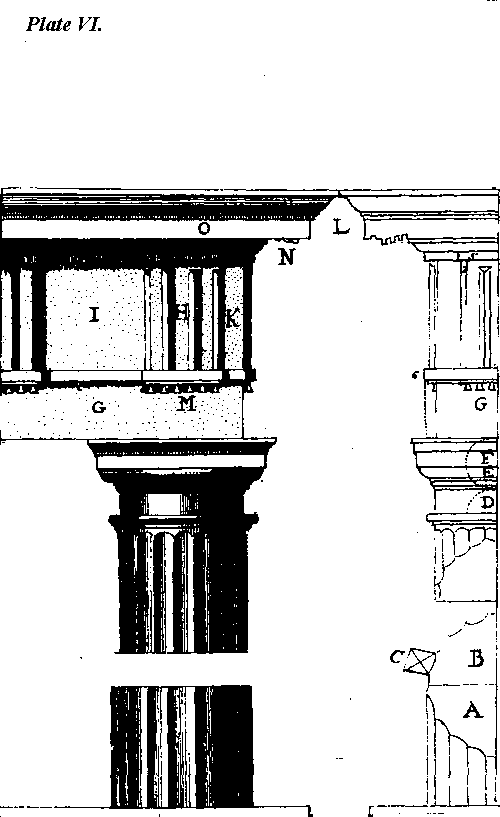
This contains the Proportions of the Jonick Order and the Attick Base: A is the Plinth of the Attick Base, which is the third part of the whole Base, of which the upper part is the fourth part of what remains after the Plinth is taken; the inferiour part is half of what remains, and the other half is the Scotia. C D is the Plinth of the Jonick Base, which is the third part of the height of the whole Base. E is the Thorus which contains three parts of seven, into which is divided what remains, the other four being for the two Scotia’s, and the two Astragals, which are betwixt the Thorns and the Plinth. F is the Capital, whose Proportion is explained in the eighth Table. G, H, I, K is the Architrave, which has four parts, viz. the Face marked G; the second marked H; the third marked I, and the Cymatium or Simaise, marked K; L is the Frise. M, N, O, P, Q is the Cornice. M is the first Cymatium; N is the Dentil; O is the second Cymatium; P is the Crown with its little Cymatium or Simaise.
This Table relates to pag. 101.
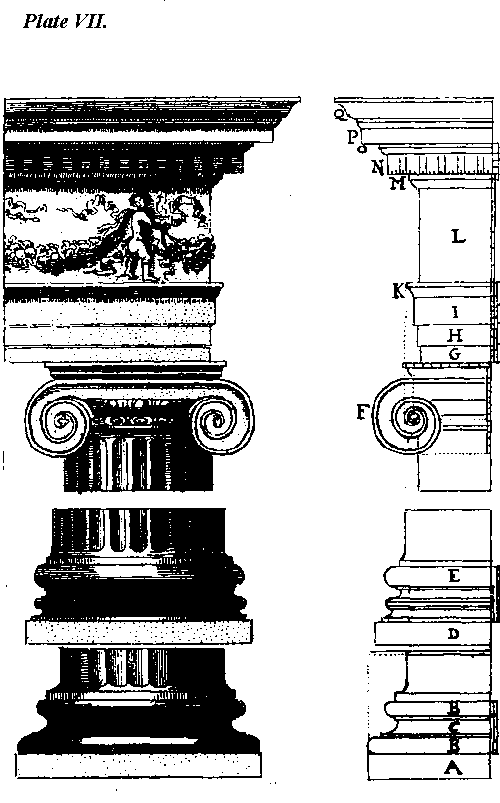
This contains the Proportions of the Ionick Capital, of which only half is seen here: A B is the half of the breadth of the Abacus, which is regulated according to the breadth of the bottom of the Column, of which one half is marked B 18; for the bottom of the Column being divided into 18, 19 are allowed to the Abacus: A C is the Retreat which must be made of the Corner A, of the Abacus inwardly, to draw the Line C D, which must regulate the Eye of the Volute over which it must cross as it passes. To make this Retreat we must take one part and a half of twelve, into which is divided the height or thickness, E F, of the whole Capital, which height is equal to half the breadth of the Abacus. This height, marked C D, is divided into nine parts and a half, of which one and a half is given to the Abacus, and four and a half from the Abacus to the middle of the Eye, which is traversed by the line G H; the Figures 1, 2, 3, 4, mark the four Centers of the first four quarters of the Volute; the four second quarters, and the four third (for the Volutte has twelve) are taken in the Diagonal 1, 3, and 2, 4. H, I, is the Astragal at the top of the Pillar which answers the Eye of the Volute. K K is the Egg or Echinus; L is the Axis of the Volutes; M M is the ceinture of the lateral part of the Volutes. This relates to pag. 103.
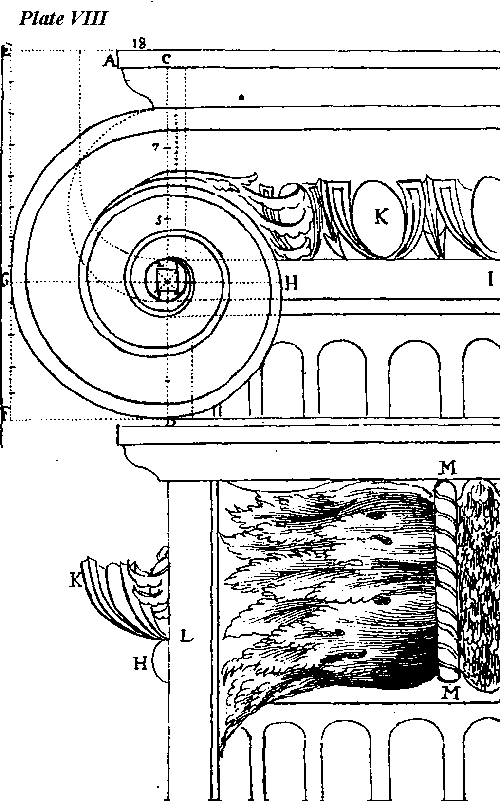
This contains the Proportions of the Corinthian Capital, which makes all the distinction betwixt Jonick and the Corinthian Order, all other Members, according to Vitruvius, being the same. A is the Corinthian Capital, which has for its height only the Diameter of the bottom of the Column; B is the Capital of the Pantheon, which is higher by a seventh part, viz. the thickness of the Abacus; C D is the height of the Capital divided into seven, of which the Abacus has one, the Voluta’s and Foliages and Stalks two, the Foliage in the Range above two, and that in the Range below two. To have the breadth of the Abacus, we must give to its Diagonal E F the double of its height C D. To have the greatness and just Proportion of its bending H, we must divide the breadth of the Abacus E G into nine parts, and give it one.
At the bottom of this Table is represented the Herb Branbursine, which grows round about the Basket, which is covered with a Tile, from which Vitruvius says the Sculptor Callimachus took the first Model of the Corinthian Capital.
This Table relates to p. 108.
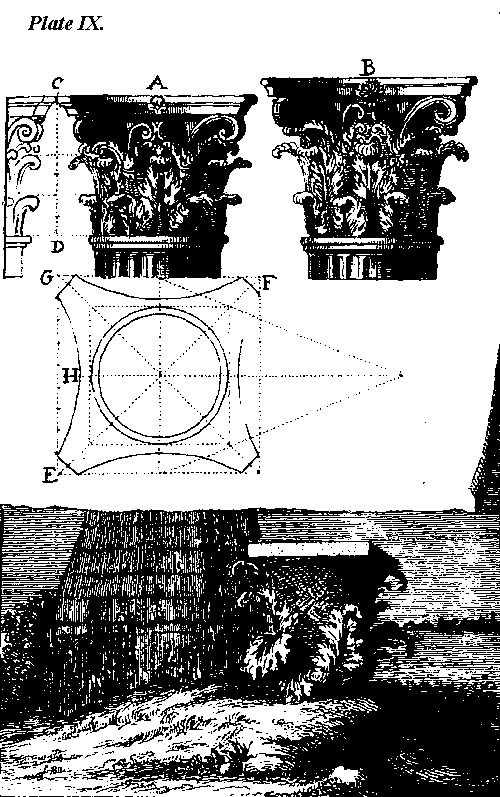
This contains the Plan and Elevation of the Theatre of the Romans. AA is the Portico which went round the Theatre below. BB are the Entries through which they parted from the Portico’s into the Orchestra C. KDEDK the Pulpitum or Stage; MM the landing-place which separated the Degrees above from those below: LM the Stairs which are between the degrees. NN the Portico above in the Theatre. PP the Passage under the degrees. TT the Stairs by which they mount to the Portico’s above. KIHIK the Scene. H the royal Gate. II the Gates of Strangers. KK the Gates in returning. OOO the Machines used in changing the Scenes. GG the part of the Theatre behind.
This Table relates to p. 125.
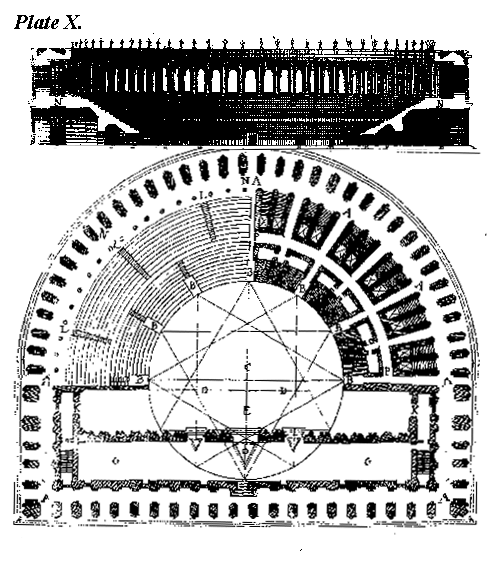
This contains the Explication of the Catapulta, which was a Machine of War used by the Ancients to dart Javelins of an extraordinary bigness. A are the two Beams one against the other, and joyn'd, which after having been drawn, pushed the Javelin with great force when they were unbent. There is one of these Beams, which is represented as being joyned to the Capital of the Machine by an Iron Pin, the other ready to be joyned when the Master of the Machine sounds the Cord with his right Hand, shall have it heightned or let down, the end marked C, as much as is necessary, to give it an equal Bent to the other. This is done by the help of an excentrical piece, which is traversed by a Cylinder, which the Master turns with a Laver, which he holds in his left Hand. D, E E is the Capital of the Catapulta. EE are the holes through which the Rope passeth to draw the Beams. F is the end of one of the Beams represented in great. G is one of the Pins which travers'd a round Eye, by the help of which the Beam is joyned to the Capital. H is the Cylinder which traverses the excentrical piece I. This Plate relates to pag. 155.
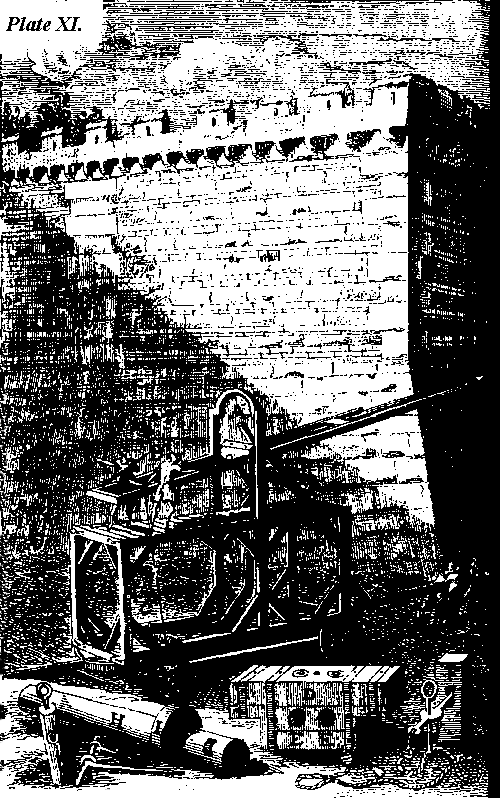
Explication of the Hardest Terms in Architecture
AABacus, from ἄβαξ; which signifies a square Trencher: In French it’s called Talloir; it’s that quadrangular Piece commonly accompanied with a Cymatium, and serves instead of a Drip or Corona to the Capital. It supports the nether Face of the Architrave and whole Trabeation. In the Corinthian and the Compound Orders, its Corners are called the Horns, the intermediate Sweep and Curvature; the Arch, which has commonly a Rose carved in the middle.
Acroteria or Acroter’s from ἀκρόν, Summa pars; they may be properly called Pinnacles, for Pins and Battlements were made sometimes more towring; but when they stood in Ranges with Rails and Balisters: Upon flat Building they still retained their Name, with this only difference, that such as were placed between the Angular Points, were stiled the Median, or middle Acroteria.
Annulets, are little square Parts turned round in the Corinthian Capital, under the Quarter-Round, called Echinus.
Ante, is a square Pillaster, which the Ancients placed at the corners of the Walls of the Temples.
Amphiprostyle from αμφὶ, Circa, and στύλος; Columna was a sort of a Temple which had four Columns in the Front of the Temple, and four in the Face behind.
Architrave, from a Mungril Compound of two Languages, αρχη Principalis, and Trabs; it’s the first Member of that which we call Entablature; in Chimnies the Architrave is the mantle; over the Jambs of the Doors and Lintels of Windows, it’s called the Hyperthron, from the Greek ὑπὲρ, super and θὑρα, Janua or Ostium.
Astragal, from the Greek word αστράγαλος which signifies the Vertebræ, or little Joints in the Neck or Heel; hence the French call it Talon, or the Heel itself: It’s a Member of Architecture joyned to Bases, Cornices, Architraves, &c. it’s round like a Ring, and therefore it’s called by the Italians Tondino.
Attiq; signifies after the manner of the City of Athens. In Vitruvius it’s the Name of the Basis which the Moderns have given to the Dorick Pillar. We call Attiq; in our Buildings, a little Order placed upon another much greater; for instead of Pillars, this little Order has commonly nothing but Pillasters of a particular Fashion and Order, which we call Attiq;
Apophyges, vide Congé.
BBAsilica, from the Greek word Βασιλεῖς Rex or King among the Ancients. It was a great Hall which had two Ranges of Pillars, and had two Isles or Wings, upon which were Galleries: These Halls, which at first were made for the Palaces of Kings, were afterwards turned into Courts of Justice, and after that into Churches; which Form has always been observed.
Ballustre is the lateral part of the Jonick Capital. Our Workmen have given it that name, because it somewhat resembles a Balluster.
CCHanel, in the Ionick Capital, is that part which is under the Abacus, and lies upon Echinus or Egg, and which has its Contours or Turnings on every side to make the Voluta’s.
Cariatides are Statues of Women, which serve instead of Pillars.
Cincture is that part which makes the middle of the Ballustre of the Ionick Voluta.
Congé in French, in Latin Apophyges, from the Greek word αποφυγή because that part of the Pillar taking as it were a rise, seems to emerge and fly from the Basis like the Proceltus of a Bone in a mans Leg, In short, it’s no more than the Rings or Ferils heretofore used at the Extremities of wooden Pillars, to preserve them from splitting, afterwards imitated in Stone-work.
Corona is properly that part of the Cornice which the French call Larmer or Drip, because it defends the rest of the Work from Wind and Weather: It is often taken by Vitruvius for all the Cornice.
Corona, called the Plat or flat Crown, is a particular Member in the Dorick Gate; it’s made by so extraordinary enlargement of the Face of the Corona or Drip, that it has six times more Breadth than Projecture. This sort of Corona is no where found among the Ancients, but only in the Writings of Vitruvius.
Cymatium, from κυμάτον, which signifies a rouling Wave; is a Member of Architecture, of which the one half is Convex and the other Concave, the one being hollow above, and the other below. There are two sorts of them, the one called the Gola or Throats, or the Doucine, whose advanced part is Concave; and the other is called by the French the Talon or Heel, whose advanced part is hollow below, as the first is above.
DDIE is the middle of the Pedestals, viz. that which is between their Basis and their Cornice. It’s so called, because it’s for the most part of a Cubit form, as Die’s are that are used in play.
Dentils, or Teeth, is a Member of the Jonick Cornice, which is square, and cut out at convenient distances, which gives it the form of a Set or Gang of Teeth.
Diastyle, from διὰ and στύλος: Columna is a sort of Edifice where the Pillars are distanced one from another the breadth of 3 Diameters of the Pillar.
Diptere, from δὶς and πτέρον: Ala signifies that which has a double Isle or Wing; the Ancients called so the Temples, which were surrounded with two Ranges of Pillars, for there two Ranges made two Portico’s, which they called Wings, we Isles, from the French word Ailes, which signifies Wings, because as Wings are on the sides of Birds, so these of Edifices.
EEChinus, from ἀπὸ τοὺ ἐχίνου, a Hedg-hog; it is a Member of Architecture, which we call a Quarter-round; it has its name from the roughness of its Carving, resembling the prickly Rhind of the Chesnut, and not unlike the Hedg-hog; it’s commonly next to the Abacus, and carved with Ovals and Darts, sometimes called Eggs and Anchors, because these pretended Chesnuts are cut in an Oval form.
Entablature signifies properly the Flooring or Lofting with Boards; it comes from the Latin word Tabulatum. In Architecture it’s that part which is composed of the Architrave, Frise, and Cornice, for in effect this part is the extream part of the Flooring, which is supported by Pillars, or by a Wall if it have no Pillars.
Eye is the middle of the Jonick Volute, which is cut in the form of a little Rose.
Eurythmie, from εὖ bene, and αριθμὸς numera: it signifies Proportion; it’s taken in its general signification in Architecture; for in its particular signification it signifies the true measure that is observed in Dancing after Musick.
Eustyle, from εὖ bene, and στὺλος a Pillar; its the Order where Pillars are rightly placed, the Intercolumniations being two Diameters and a quarter.



